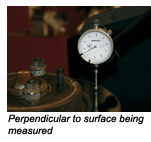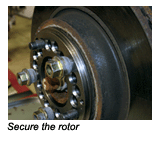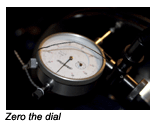Runout in the Bearing Face
Rotate the hub bearing assembly by hand. Any roughness, looseness or noise from the bearing is an indication of damage.

To check a hub bearing assembly’s internal clearance, use a dial indicator. To obtain accurate readings from the dial indicator it is important to thoroughly clean and smooth the surfaces where the dial indicator base and tip will be placed.
The dial indicator base should be placed or clamped rigidly a secure portion of the suspension. Position the indicator tip perpendicular on the wheel pilot as close to the center of the hub assembly as possible.
Grasp the wheel flange at the 3 o’clock and 9 o’clock positions, and push while oscillating the hub bearing assembly approximately 90° side-to-side at least five times. Set the dial indicator to zero. Next, pull while oscillating the hub bearing assembly approximately 90° side-to-side at least five times.
Mark the high and low spots of the runout on the face.
Observe the total indicator movement. If it exceeds the specs, replace the bearing assembly.
 Runout in the Rotor
Runout in the Rotor
Tighten down the rotor with the correct conical washers and torque.
Using a micrometer to check parallelism. Measure rotor thickness at six equally spaced points around the circumference of the rotor. More than .0005 in. of variation means the rotor needs to be resurfaced.
Check the taper with the micrometer. Rotor taper (the difference in thickness between the inner and outer edges of the rotor face) should not exceed .003 in.
To check lateral runout, the dial indicator’s tip of the indicator against the rotor’s face in the center.
Mark the high and low spots of runout in the rotor.
 Matching the Hub to the Rotor
Matching the Hub to the Rotor
By measuring and marking the high and low spots of runout in the hub and rotor, it is possible to match the high spot of runout in the hub with the low spot of runout in the rotor.
Match and measure.
This technique can be used to minimize the amount of material removed with a on-the-car brake lathe.






